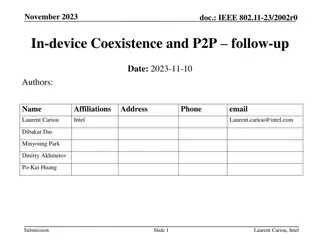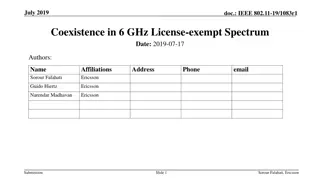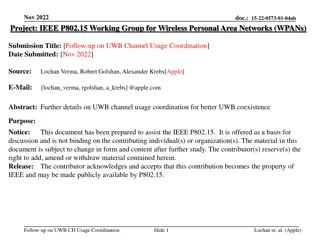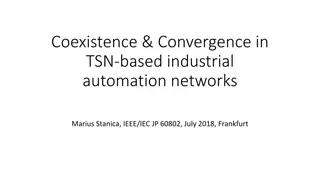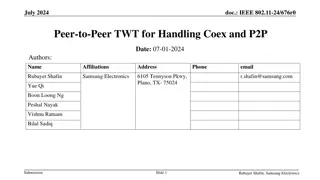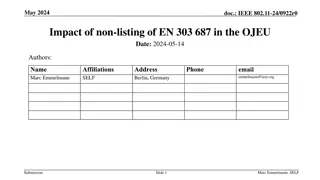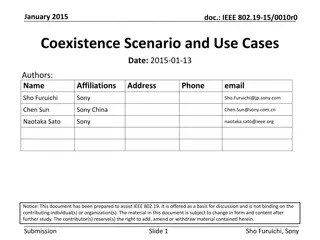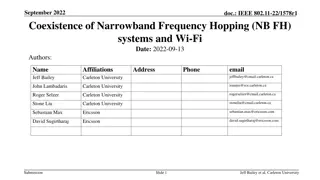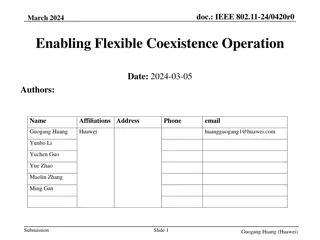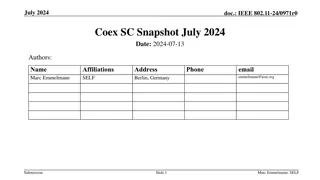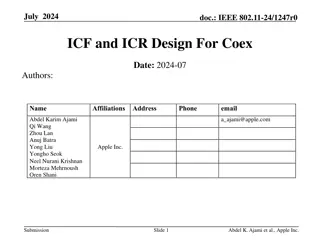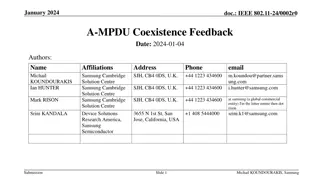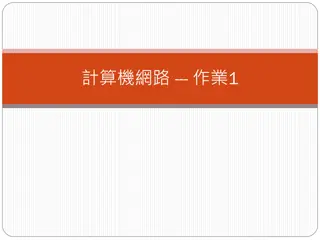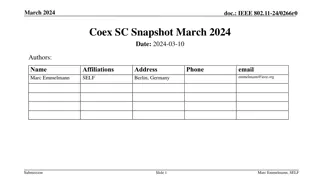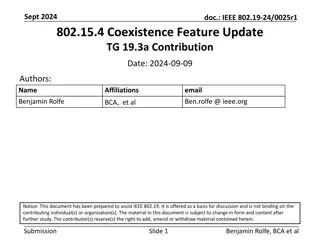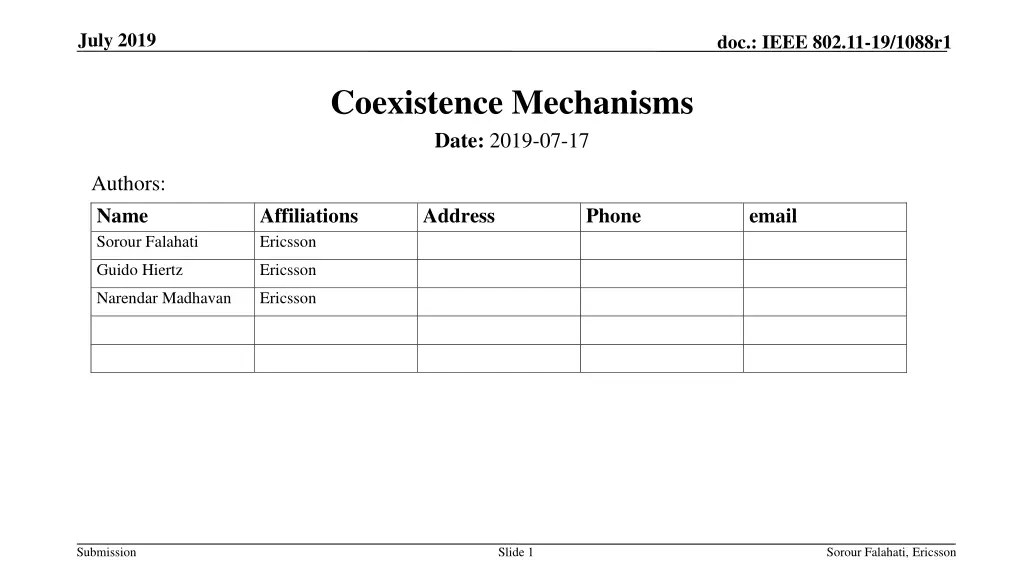
Coexistence Mechanisms in IEEE 802.11-19/1088r1 Document
Explore the key elements for coexistence in the IEEE 802.11-19/1088r1 document, including sensing mechanisms, calibrated protocols, and threshold values. Discover how devices defer based on thresholds, ensuring effective spatial reuse and channel protection in wireless networks.
Download Presentation

Please find below an Image/Link to download the presentation.
The content on the website is provided AS IS for your information and personal use only. It may not be sold, licensed, or shared on other websites without obtaining consent from the author. If you encounter any issues during the download, it is possible that the publisher has removed the file from their server.
You are allowed to download the files provided on this website for personal or commercial use, subject to the condition that they are used lawfully. All files are the property of their respective owners.
The content on the website is provided AS IS for your information and personal use only. It may not be sold, licensed, or shared on other websites without obtaining consent from the author.
E N D
Presentation Transcript
July 2019 doc.: IEEE 802.11-19/1088r1 Coexistence Mechanisms Date: 2019-07-17 Authors: Name Sorour Falahati Affiliations Ericsson Address Phone email Guido Hiertz Ericsson Narendar Madhavan Ericsson Submission Slide 1 Sorour Falahati, Ericsson
July 2019 doc.: IEEE 802.11-19/1088r1 Coexistence Mechanisms The key elements for coexistence are A calibrated sensing mechanism Listen for transmissions from other nodes A listen-before-talk (LBT) protocol A protocol to process the sensing results prior to transmission Maximum channel occupancy time (MCOT) limits Limits on transmit duration when transmitting Adjacent channel protection Requirements on protection of adjacent channels when transmitting Submission Slide 2 Sorour Falahati, Ericsson
July 2019 doc.: IEEE 802.11-19/1088r1 Sensing Threshold IEEE 802.11a/n/ac use two thresholds, one for own technology, higher for other technologies IEEE 802.11ax uses more than two thresholds depending on spatial reuse option Preambles are used to differentiate between own and other technology/network and choose a different threshold for them 3GPP technologies use a single threshold for all technologies Submission Slide 3 Sorour Falahati, Ericsson
July 2019 doc.: IEEE 802.11-19/1088r1 Sensing Threshold IEEE 802.11ax devices defer to IEEE 802.11a/n/ac and ax (own network) devices at -82 dBm 802.11ax 802.11a/n/ac/ ax_own_nwk -62 dBm -82 dBm Submission Slide 4 Sorour Falahati, Ericsson
July 2019 doc.: IEEE 802.11-19/1088r1 Sensing Threshold IEEE 802.11ax devices defer to IEEE 802.11ax (other network) devices at threshold greater than -82 dBm (spatial reuse) 802.11ax 802.11ax other_nwk -62 dBm -82 dBm Submission Slide 5 Sorour Falahati, Ericsson
July 2019 doc.: IEEE 802.11-19/1088r1 Sensing Threshold IEEE 802.11ax devices defer to other technology devices at threshold -62 dBm 802.11ax Other technology -62 dBm -82 dBm Submission Slide 6 Sorour Falahati, Ericsson
July 2019 doc.: IEEE 802.11-19/1088r1 Sensing Threshold Sensing threshold determines the level of spatial reuse by determining the level at which a node defers to another node Trade-off between reuse (proportional to channel access opportunities) and SINR The appropriate level of the sensing threshold to maximize system performance depends on Deployment density Radio environment (Indoor residential, Indoor office, Outdoor urban, Outdoor suburban, ) The appropriate level of the sensing threshold should NOT depend on the characteristics of neighboring nodes Own or other network Own or other technology Submission Slide 7 Sorour Falahati, Ericsson
July 2019 doc.: IEEE 802.11-19/1088r1 Sensing Threshold for 6 GHz A solution that satisfies the clear need for adaptation of sensing thresholds in the real world without violation of regulations is needed Co-existing networks, even when using the same technology will not be aware of the thresholds used by each network A single common maximum energy detection threshold between all nodes and technologies is the only solution that is viable and future proof (addressed further in companion document) Additional sensing mechanisms for sharing within a network can be independently used as long as these mechanisms comply with the single common maximum energy detection threshold across all technologies. Examples: A network operating without scheduling can use preambles for sharing (e.g., IEEE 802.11a/n/ac/ax) A managed network can use scheduled operation for sharing (e.g., LTE, NR, IEEE 802.11ax) Submission Slide 8 Sorour Falahati, Ericsson
July 2019 doc.: IEEE 802.11-19/1088r1 Adjacent Channel Protection Adjacent channel leakage ratio is an important requirement for good coexistence of nodes operating in adjacent channels 3GPP standards require ~9 dB (35 dB vs. 26.3 dB) additional protection compared to IEEE 802.11 Carrier 1 Carrier 2 Power spectral density Submission Slide 9 Sorour Falahati, Ericsson
July 2019 doc.: IEEE 802.11-19/1088r1 Adjacent Channel Protection with Wideband Carriers IEEE 802.11 defines spectral emissions mask for transmissions on parts of wideband carriers (e.g. 80 MHz) Spectral emission masks for Wi-Fi preamble puncturing where N is the number of contiguous punctured 20 MHz channels Transmit spectral emission mask from the latest version of the ETSI BRAN Harmonized standard EN 301 893 v2.1.1 Submission Slide 10 Sorour Falahati, Ericsson
July 2019 doc.: IEEE 802.11-19/1088r1 Adjacent Channel Protection with Wideband Carriers The ETSI spectral mask requirements are not met for various cases Can cause harmful interference to already deployed LTE-LAA systems designed to meet ETSI masks Comparison of the overall spectral emission masks for the [1 1 0 1] channel puncturing pattern Comparison of the overall spectral emission masks for the [1 0 0 1] channel puncturing pattern Submission Slide 11 Sorour Falahati, Ericsson


